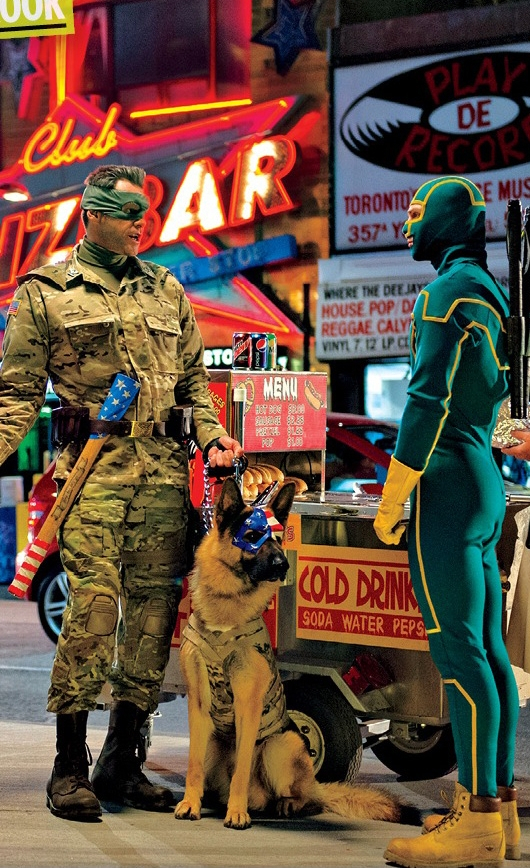http://www.moviescene.nl/p/143774/foto_jim_carrey_in_kick-ass_2

Yup, that's right: Jim Carrey is playing a character (named Colonel Stars and Stripes, an obvious reference to the renowned super-patriot Captain America) in Kick-Ass 2. And why not? He's no stranger to comicbook movies, having done Batman Forever and The Mask in the past. With such a track record, you can of course doubt he's a stranger to good comicbook movies, but for now I have full faith in Kick-Ass 2, considering all the old favorites (minus Nicolas Cage's character Big Daddy) are back with a vengeance. There's just little than can go wrong with this movie, which is still being based around a fairly simple premise: ordinary people take to the streets in silly costumes and beat up bad guys. Or so they think. It worked fine the last time around. Naturally there is the danger of the film feeling redundant due to repetition, or the presence of a new director (Jeff Wadlow) who has yet to fully prove his competence in the chair, but so far no really awkward news has reached my ears about this project (except maybe for Matthew Vaughn not returning as director, but at least he will still produce). Judging from this single picture (which is much too little to make a truly based judgment about the whole film) Kick-Ass 2 is simply continuing what Kick-Ass started, meaning we'll get more wacky characters in doubtful mental conditions fighting crime in overly outrageous and no doubt excessively violent manner. Plus more Hit Girl. What's not to like?!
I also, finally, got to see The Hobbit: An Unexpected Journey in IMAX 3D HFR, now that the Christmas break has ended and there's finally some showings of the film that are not sold out. Of course I had already seen the movie in the regular 3D version - which I mentioned before was fucking awesome, an opinion I'll stick by - so I got to focus a bit more on the technology behind the film's projection than on the actual movie itself. I must say, HFR is not as bad as I feared it would be. I had already had a few sneak peeks through the projection booth's windows, at which point I was not wearing glasses so it looked absolutely hideous, due to the motion of the camera and characters which seemed cranked up a little too much, making it feel unnatural. As it turns out, HFR is indeed a tool in service of 3D projection. The image looks a lot more quieted down and smooth when wearing the necessary glasses, and it's indeed tremendously sharp to behold. There was only a handful of scenes, mostly concerning fast paced action or close-ups of characters's hands and objects, where you were made aware the film was indeed shot at 48 frames per second, and in those few instances it did indeed momentarily make the projection technology draw attention to itself: this had to be expected, since all the fuss about HFR should warrant the occasional feeling of a different viewing experience, positive or negative.
The sharpness of the imagery does make the job of the visual FX teams creating the movie's vast array of digital effects more difficult. Digital effects stand out more in 48fps, being exposed for the pixels they are. It was clear the FX teams worked overtimes to make their computer generated wizardry appear photorealistic, and for the most part, they succeeded. Gollum was the absolute highlight, looking about as real as he could ever hope to get and, also thanks to Andy Serkis' input of course, giving a totally compelling performance. That said, several shots of charging Wargs and vicious Goblins looked less convincing, but never truly bad. It's clear movies that will be shot in HFR better have the budget to make their VFX look good, since if they fail in this regard, lousy digital imagery will destroy the spectator's viewing experience by exposing the cinematic trickery for what it is.

The question now of course remains: where does HFR go from here? So far the reception of Peter Jackson's new preferred way of shooting a movie has been lukewarm in Hollywood. Which is not surprising, since basically HFR at this point is a gimmick in a gimmick: it looks good in 3D, but has yet to prove visually pleasing in the regular 2D-format, which is still (fortunately) the dominant way of film projection. Though James Cameron has expressed interest in the technology, it'll be years before we see HFR applied to other movies than the upcoming pair of Hobbit sequels. And if the recent evolution of the current 3D-format is any indication, greedy producers hoping to cash in on the phenomenon's hype will quickly apply a cheaper type of HFR to things like low budget horror movies, all too easily satiating the market and ruining HFR's name in the process by not convincing the audience of the need for the format. It can of course be argued there is no particular need for HFR at all. After all, the regular 3D version of The Hobbit: An Unexpected Journey already was fully engaging as a marvelously pleasing visual presentation, and few audience members complained about image blurring during action sequences. Mostly, viewers were too busy focusing on the movie itself, the story, the characters, the things that still remain, and for that matter will always remain, the most important ingredients for making a good film. At least Peter Jackson still understood that part of moviemaking too.
Geen opmerkingen:
Een reactie posten